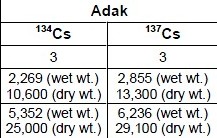
Lichen sample from mid-2011 expressed in picocuries/kilogram — Lichen on the island had less than 70 pCi/kg of Cs-137 in 1997.
– US Gov’t Headline: Alaska island “appears to show impacts from Fukushima” — “Significant cesium isotope signature” detected — Scientists anticipate more marine life to be impacted as ocean plume arrives (VIDEO) (ENENews, Nov 14, 2013):
Amchitka Island, Alaska, Biological Monitoring Report 2011 Sampling Results, September 2013: To determine what [Fukushima Dai-ichi’s] direct release of radioactive materials into the atmosphere might have contributed to the background radiation on Amchitka and Adak Islands, semiquantitative gamma spectrometry measurements were made […] The results imply that Dolly Varden [a type of fish], rockweed, and to a lesser extent, Irish lord [a type of fish] appear to contain a significant cesium isotope signature from Fukushima Dai-ichi. The estimated 134Cs/137Cs activity ratios in pooled fauna samples at the time sampled ranged from <30 to about 60 percent. Observations of Fukushima-derived fallout impacting on this region are supported by findings of elevated levels of 134Cs (and 137Cs) in lichen and soil collected from both the Adak and Amchitka regions. […]
Department of Energy: Biological Monitoring at Amchitka Appears to Show Impacts from Fukushima Dai-ichi Incident […] The U.S. Department of Energy Office Legacy Management (LM) has a long-term stewardship mission to protect human health and the environment from the legacy of underground nuclear testing conducted at Amchitka Island, Alaska, from 1965 to 1971. […] Atmospheric monitoring in the United States showed elevated cesium activities shortly after the [Fukushima] nuclear incident. LM scientists anticipated that atmospheric transport of cesium would potentially increase the cesium activities in the 2011 biological samples collected near Amchitka. Because cesium-134 has a relatively short half-life of 2 years and indicates leakage from a nuclear reactor, it is a clear indicator of a recent nuclear accident […] Because the Amchitka 2011 sampling event occurred soon after the Fukushima nuclear accident, the biota impacted by atmospheric precipitation showed the greatest impact (e.g., species that live in freshwater or shallow ocean waters) when compared to marine biota living in deeper water. This is because ocean currents are a slower transport process than wind currents. LM scientists anticipate that the marine biota will show the impacts of Fukushima during the next sampling event, currently scheduled to occur in 2016. […]
Watch the DoE video describing the 2011 monitoring event here
Related info:
– Hundreds Of Sea Turtles Wash Up Dead On Pacific Coast – Dogs ‘Stopped Breathing And Died Almost Instantly’ When Eating Them
– Starfish Turn To ‘Slime’ Along Pacific Coast … ‘We’re Talking About A Loss Of Millions And Millions’
– Fishermen Boats Surrounded By Hundreds Of Dead (Nearly Extinct) Eastern Pacific Green Sea Turtles
– Something Is Killing Life All Over The Pacific Ocean
– Head Researcher “Is Sounding The Alarm’ Over Dramatic Changes In Pacific Northwest Killer Whales
– 28 Signs That The West Coast Is Being Absolutely Fried With Nuclear Radiation From Fukushima
